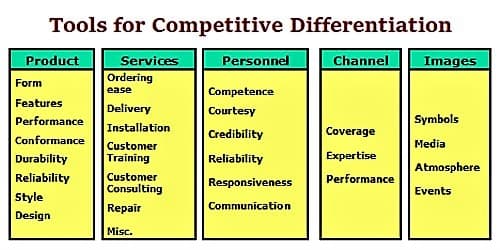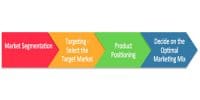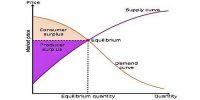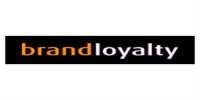Differentiating is an act of designing a set of meaningful difference to distinguish the company’s offering from a competitor’s offering. Competitive differentiation is a premeditated positioning approach an organization can carry out to set its products, services, and brands apart from those of its competitors. Here we will examine how a company can differentiate its market offering along five dimensions: Product, Services, Personnel, Channel and Image.
Product Differentiation
- Differentiation in the physical product takes place in different ways;
- Form: Size, shape or physical structure.
- Features: Features are characteristics that supplement the basic functions of the product.
- Performance: It refers to the level at which products primary characteristics operate. Performance may be low, high, average or superior.
- Conformance: Degree to which products units are identical and meet promised target specification.
- Durability: It is a measure of the product’s expected operating life under natural and/ or stressful condition.
- Reliability: Measuring of probability that product will not malfunction or fail within a specific period.
- Reparability: It is a measure of the ease of fixing a product when it malfunctions or fails.
- Style: It describes the product’s look and feels to the buyer.
- Design: It is the totality of features that affect how a product looks and functions in terms of consumer requirements.
Service Differentiation
When the physical product cannot be easily differentiated, success often lies in adding more value- adding services and improving their quality. Service differentiation is:
- Ordering ease: How easy it is for the customers to place an order with the company?
- Delivery: How well the product or service is delivered to customers. It includes speed, accuracy, and care attending the delivery process.
- Installation: It refers to work done to make a product operational in its planned location.
- Customer Training: It refers to training the customer’s employees to use the vendor equipment properly and efficiently.
- Customer Consulting: It refers to data, information systems and advising services that the seller offers free or for a charge.
- Maintenance and repair: It refers to a company’s service programs for helping customers to keep the purchased product in good working order.
- Miscellaneous: Company .may offer a better product warranty or merchandise contract than competitors.
Personnel Differentiation
This can be done by hiring and training better people than competitors do. Better-trained people exhibit some characteristics. These are:
- Competence: Possess skill and knowledge,
- Courtesy: Friendly, respectful Considerate,
- Credibility: Trustworthy,
- Reliability: Perform service consistently and accurately,
- Responsiveness: Respond quickly to customers’ request and problems,
- Communication: Make efforts to understand the customer and communicate clearly.
- Channel Differentiation: Company can achieve differentiation through the way they shape the distribution channel: Channel Coverage, Expertise, Performance
Image Differentiation
Buyers may respond differentially to the company image or brand image by:
- Symbols: Symbol triggers company or brand recognition.
- Media: Written or audiovisual.
- Atmosphere: The physical space in which an organization produces delivers and services.
- Events: Build identity through the type of events it sponsors.
















